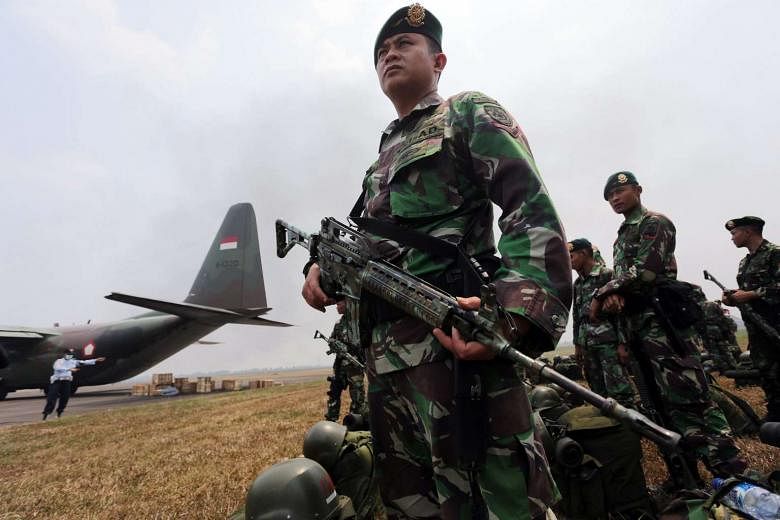Indonesia is calling in more than 1,000 troops to help fight fires raging out of control near Palembang, blanketing the capital of South Sumatra province in hazardous, choking haze.
Winds have blown the acrid smoke from southern Sumatra northwards, reaching Riau province close to Singapore, where air quality plummeted yesterday.
About half of the 1,059 soldiers arrived in Palembang around noon yesterday, bringing with them water pumps and masks as they geared up for a ground offensive. The remaining soldiers arrived in the afternoon.
The deployment is the first since mid-2013, when uncontrolled forest and land fires in Riau and southern Sumatra triggered thick haze that smothered Singapore and Malaysia, causing pollutant indexes to hit historic levels.
This time round, the fires are located predominantly in the southern part of Sumatra. The blazes are being exacerbated by the El Nino weather pattern that continues to strengthen. El Nino typically reduces rainfall in South-east Asia and can cause severe drought, leaving forests ripe for serious fires.
"Soldiers have to comb every corner of the forest that caught fire or that has potential to catch fire. Don't give up because giving up in this condition is not the character of an Indonesian soldier," said Indonesia's armed forces commander, General Gatot Nurmantyo, when sending soldiers off from Jakarta.
The air quality index in Palembang reached hazardous levels yesterday, forcing schools to close until at least tomorrow. Visibility ranged from 100m to 300m early yesterday. The index in Palembang was above 300. A reading of zero to 50 is considered good, 51-100 moderate, 101-200 unhealthy, 201-300 very unhealthy, and above 300 hazardous.
In Riau province, the worst-hit area was Pelalawan where visibility was only 100m, and the index above 300. Schools were ordered to close.
The air quality in Dumai, also in Riau province, improved slightly after good rainfall on Wednesday.
"The skies in Dumai have improved quite a lot. It's below 300 now, and is also cloudy at the moment," Mr Basri, head of Dumai's environment department, told The Straits Times.
Air pollution in Riau's capital Pekanbaru, which reached hazardous levels on Wednesday, improved yesterday. The visibility level was up to more than 1,000m.
Pinpointing those responsible for the fires can be tough, officials say. Most are started by people, including farmers and illegal loggers, and some by companies clearing land. Fires often start outside plantation concessions and then move inside. Some concessions also have communities living on non-developed land within their boundaries, complicating the picture further.
"We are mapping it out to identify areas that have the potential to have fires. We know most of them are not spontaneous fires, because they are started intentionally. Going forward, we will guard these potential fire areas for prevention," Gen Gatot said.
Fires have also covered much of Kalimantan in smoke, with parts of Central and East Kalimantan provinces covered in dense haze, according to the latest regional haze map produced by the Meteorological Service Singapore.
Hundreds of hot spots have also been reported in West Kalimantan and the haze has spread to Sarawak, disrupting flights. Visibility was down to 400m in Kuching yesterday morning.

